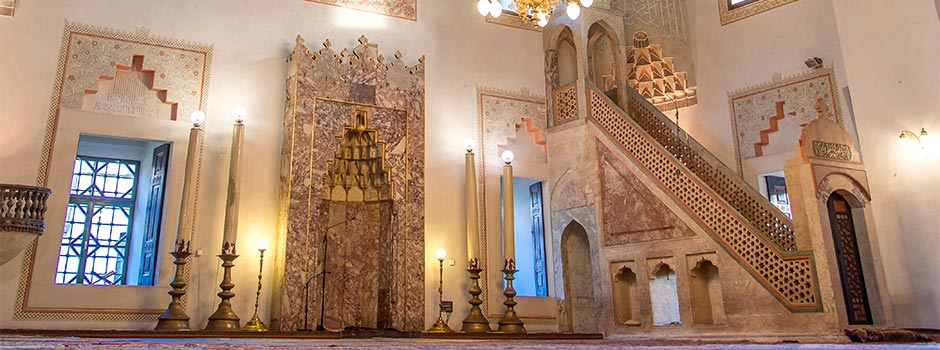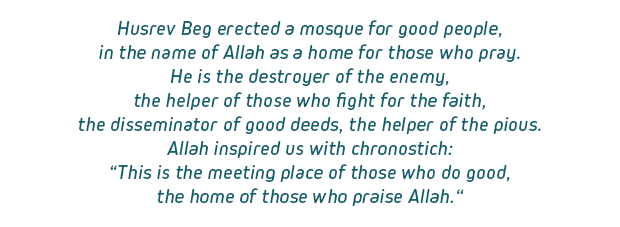
ARCHITECTURE Ottoman Masterpiece in Sarajevo
Dec 12, 2020 FEATURE, Architecture

This article is a part of the project 'Promotion of the Ottoman Cultural Heritage of Bosnia and Turkey' which is organized by Monolit, Association for Promoting Islamic Arts and supported by the Republic of Turkey (YTB - Prime Ministry, Presidency for Turks Abroad and Related Communities).
_IslamicArtsMagazine_01.jpg) The Gazi Husrev Beg Mosque / Photo © Islamic Arts Magazine
The Gazi Husrev Beg Mosque / Photo © Islamic Arts Magazine
The Gazi Husrev Beg Mosque, finished in 1531, is the most impressive Ottoman monument in Bosnia and Herzegovina. It was long believed that it was designed by the great Ottoman architect Mimar Sinan. A dilemma was eliminated when scholars analyzed historical sources and were unable to find any mention of Sarajevo or Gazi Husrev Beg Mosque in connection to Mimar Sinan. Furthermore, Sinan's first project was the Husrev Pasha Mosque in Aleppo which was finished in 1537, six years after the Sarajevo Mosque was already built. The mosque in Aleppo is a pioneer work with evident imperfection in architectural decoration and development. A difference between the Gazi Husrev Beg Mosque in Sarajevo and the Husrev Pasha Mosque in Aleppo is clear, the Husrev Beg Mosque in Sarajevo was done by an experienced architect.
The founder of the Mosque is the 16th-century Ottoman governor of Bosnia, Gazi Husrev Beg. He was a member of the Ottoman royal family as his mother Seljuk Sultan was a daughter of Sultan Bayezid II. This certainly helped him to hire the royal architect, capable of the challenge, most probably the chief Ottoman architect Acem Esir Ali, Mimar Sinan's predecessor.
_IslamicArtsMagazine_05.jpg) The Gazi Husrev Beg Mosque, view from the munara / Photo © Islamic Arts Magazine
The Gazi Husrev Beg Mosque, view from the munara / Photo © Islamic Arts Magazine
He was captured during Sultan Selim Yavuz's campaign against Safavid Persia in 1514. His full name was Alaadin Ali Bey Bin Abd Al Kareem. In the Ottoman documents he was recorded as Mimar Acem Esir Ali, sometimes only as Mimar Ali. The additions to his name were Acem, meaning he was from Persia and Esir, meaning he was captive. The best-known works of Acem Esir Ali are the Sultan Selim Yavuz Mosque in Istanbul built in 1522 and the Mimar Acem Ali Mosque finished a year later. Amongst the monuments attributed to him is also the Gazi Husrev Beg Mosque in Sarajevo. Its proportions, dimensions and high aesthetic values indicate that it was designed by an architect of the Ottoman Sultan's atelier. The only suitable for such a project at the time was Mimar Acem Ali.
The Mosque was designed as part of the bigger architectural complex and includes two mausoleums (turbe), a courtyard with the burial ground, abdesthane, fountain, muvakkithane, maktab, madrasa, haniqah, public kitchen and a clock tower. Besides the religious complex Husrev Beg also built bezistan, han, numerous shops and hamam. Because of the great number of his endowments, he is considered the most deserving of the prosperity of Sarajevo in Ottoman times.
The Gazi Husrev Beg Mosque is the most important and architecturally most valuable endowment by Gazi Husrev Beg. It has a monumental courtyard with four gates and a fountain in the middle of the courtyard. Although it was built in 1531, the massive walls, architectural decoration and entire appearance are closer to the late 15th century Ottoman architecture.
_IslamicArtsMagazine_03.jpg) The courtyard of the Gazi Husrev Beg Mosque / Photo © Islamic Arts Magazine
The courtyard of the Gazi Husrev Beg Mosque / Photo © Islamic Arts Magazine
_IslamicArtsMagazine_04.jpg) Mausoleums (turbe) next to the Gazi Husrev Beg Mosque / Photo © Islamic Arts Magazine
Mausoleums (turbe) next to the Gazi Husrev Beg Mosque / Photo © Islamic Arts Magazine
The entrance of the Mosque has a beautiful portico vaulted with five small domes. The part of the portico assembly is the portal with finely crafted muqarnas and chronogram with the following text in Arabic:

The portal was decorated in the 19th century during Austro-Hungarian rule. Besides its pseudo-oriental floral decoration, it has two calligraphic inscriptions by Husein Rakim Islamovic. It must be said that Islamovic learned calligraphy in Istanbul under the supervision of eight calligraphy masters and received four diplomas in calligraphy.
Upon entering the Mosque one finds himself in the main prayer hall, under the 24.40 m height dome with a diameter of 13.40 m. Below the main dome is the gallery used in the past time to light the lamps which can be reached by a path built into the Mosque wall. The prayer space extends facing the qibla with the semi-dome above the mihrab. It also extends to the southeast and northwest with two extra spaces vaulted with smaller domes. No other mosque in Bosnia has a similar layout.
_IslamicArtsMagazine_02.jpg) The interior of the Gazi Husrev Beg Mosque / Photo © Islamic Arts Magazine
The interior of the Gazi Husrev Beg Mosque / Photo © Islamic Arts Magazine
The monument has the 21st-century floral decoration in pseudo-ottoman style with exception of the main portal done in the 19th century, mentioned above. Besides Rakim Islamovic's calligraphy, the rest of the calligraphic works were done by contemporary Bosnian calligrapher Hazim Numanagic.
Next to the mosque stands 45 meters high minaret. It has a balcony (serefe) with no decoration, it is believed that it was lost over time. One of the most beautiful views of Sarajevo is from the minaret. It is an interesting fact that the call to prayer is performed directly from the minaret without any speakers.
Near the Mosque are two mausoleums (turbe). The bigger belongs to the Gazi Husrev Beg and the smaller one to Murat Beg Tardic, the commander of Husrev Beg's army and the first trustee of his endowments. Due to the analogy, it is considered that both mausoleums were designed by Mimar Acem Ali.
Comments
Add a comment